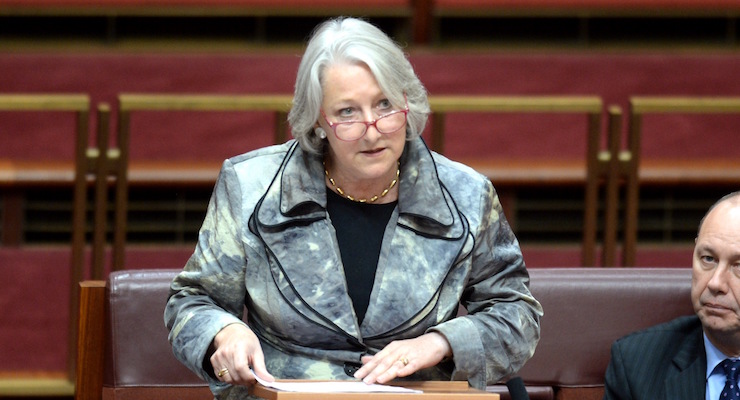
If Scott Morrison is going to change the Liberal Party’s culture, he’ll have to take on Queensland first — and good luck with that given the key role the state played in delivering victory at the last federal election.
The telling figures that demonstrate the recidivist state of the Queensland LNP come from the Liberal Party itself. A Menzies Research Centre study on gender and politics published in 2020 shows that Queensland was the only state to go backwards in terms of the number of female candidates at the last federal election, while overall the national number edged up slightly.
The study shows that in the 2016 election 23.3% of Queensland LNP candidates were female, dropping to 17.4% in 2019. The percentage of female candidates rose slightly in NSW (by 3%), was flat in Victoria and West Australia, and rose by 12% in South Australia.
Separately, an Inq analysis of the 2019 election result shows that just three of the 23 Queensland LNP members elected to the Parliament were women. Elsewhere in Australia the numbers were also low, but none as low as Queensland. At the same time the Queensland LNP outperformed all other states when it came to seats won. The Queensland LNP won 23 out of the 30 federal seats in the state.
The former Queensland Liberal Party senator, Sue Boyce, pointed to the growing conservatism of the Queensland LNP as a concern as she left Parliament back in 2014.
“In the past few months I have been asked numerous times if, as a moderate and a feminist, I am concerned about our party’s perceived move to the right. Yes, I am concerned — but I am also hopeful,” she said. “I also expect that pragmatism will ultimately triumph.”
Boyce herself had been the first woman in 30 years to represent the Queensland Liberal Party in the Senate.
The numbers neatly sum up the challenge the party — and in particular PM Scott Morrison — faces when it comes to transforming its male-dominated culture into something more balanced and in line with the general community.
Nothing succeeds like success. And for now the Queensland LNP machine and its leaders have the power. But figures such as Peter Dutton and Stuart Robert will need to be on board as advocates for real change to happen.
Whatever else, according to Boyce, the success of the Queensland branch makes it almost impossible for a Liberal prime minister to intervene in preselections to oust a sitting member.
“It’s a tradition for the PM to endorse a sitting member,” Boyce pointed out. “It even happened with [former Queensland MP] Peter Slipper.” (All members of the LNP were assured of endorsement after the Liberal and National parties merged in 2008, notwithstanding Slipper’s alleged misuse of travel allowances. It was later revealed he had sent text messages with vulgar euphemisms for female genitalia.)
Another Queensland LNP alumnus is alleged upskirt photographer and online harasser Andrew Laming, who now faces an Australian Electoral Commission investigation into his alleged undeclared use of multiple social media accounts, adding to the “empathy training” regime he is undergoing.
While Queensland is at the sharp end of the Liberal Party’s gender problems, the Menzies Research Centre identified other issues the party faces as it confronts the growing gap between it and the ALP on female representation (46% of Labor MPs are women, compared with 26% of all Coalition MPs).
The report also notes that Liberal support among women relative to men has waned over the last 20 years, particularly among younger voters. Labor’s strengthening female vote, however, has coincided with an increasing number of Labor women preselected in winnable seats.
So what are the main problems?
The alcoholic’s pledge: first admit you have a problem
“If the experience of researching this report is any guide,” the study found, “a significant number of Liberals either deny, or prefer not to admit, that gender imbalance matters. Others seem to think that to discuss the issue openly would play into the hands of their political opponents.
“The first step in addressing the representation of women in the Liberal Party, therefore, is to acknowledge that the party does in fact have a problem.”
Rejection of quotas on ideological grounds
Quotas might have lifted the number of female ALP members in Parliament but the Liberal Party opposes them.
“Discrimination is discrimination, even if labelled positive,” the study asserts. “Labor-style quotas undermine the principles of competitive enterprise and reward for effort.”
(Targets, on the other hand, were acceptable. These model the approach the corporate sector has taken in Australia.)
A lack of data, despite calls for baseline numbers
Back in 2013 the party’s federal women’s committee recommended the party collect data from all levels of the organisation. As of 2020 it hadn’t — a failure which the Menzies Centre says hindered change.
The study concluded: “The underrepresentation of women in the Liberal Party begins in the Young Liberal movement, continues through to the senior membership of the party and is evidenced in every level of party leadership.
“The party must begin to benchmark the participation of women, not just in terms of grassroots participation but also in terms of preselection and electoral success at the state and federal levels. Without this base-level data, targeted intervention will prove impossible.”
The Menzies Centre study demonstrates how fundamentally the party has cast arguments for the greater participation of women in politics as a capitulation to “feminists on the left”.
“The debate has become clouded with notions of victimhood, oppression and discrimination from which Liberals justifiably recoil,” the study asserts. “The word sexism, like racism, has been devalued by overuse.”
The study also quotes the words of Senator Linda Reynolds: “I am neither a gender warrior nor an advocate of quotas, and I do not identify as a feminist, or at least what feminism appears to have morphed into today. The sisterhood’s battle-cry remains a narrow and angry left-wing narrative, one of victimhood, and one that demands women receive special treatment, simply because we are women, their solution is quotas to achieve equality of outcome.”
This is the Linda Reynolds who, as defence minister, was earlier this year forced to apologise — and pay out an undisclosed sum — for calling alleged rape victim Brittany Higgins “a lying cow” after the former staffer claimed a lack of support from Reynold’s office.
Another sobering footnote for the party is that the study’s co-author, Nicolle Flint, has decided to leave Parliament rather than endure more gendered abuse at the hands, she says, of political opponents. Flint had worked on three iterations of the study since 2015.
Even more sobering: none of this made a difference at the Queensland ballot box in 2019. The issue of jobs linked to the Adani coal mine was widely credited with delivering swings of up to 15% to LNP seats.








Off topic by miles, but could you at last tell us David how you feel about the fuss you provoked in your Crikey piece about recovered memory? As an uninformed and disinterested bystander I went from nthinking: “Christ, this is sensational!” to thinking “Christ, how can he have got it wrong?” and, finally, “If he got it wrong where is the mea culpa?” I think we deserve an answer.